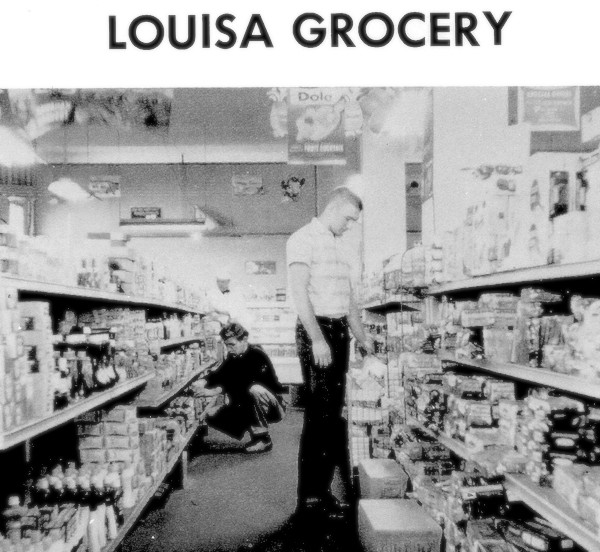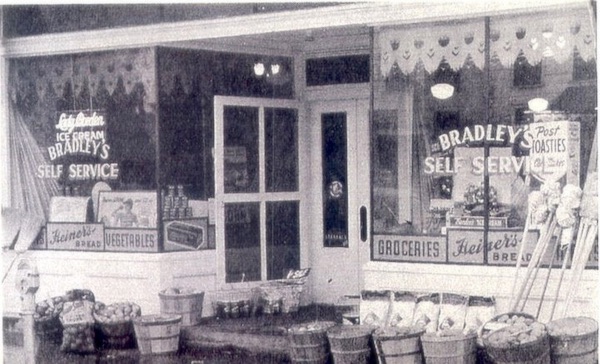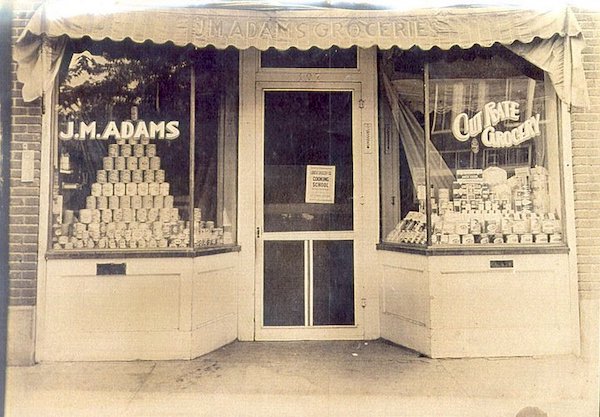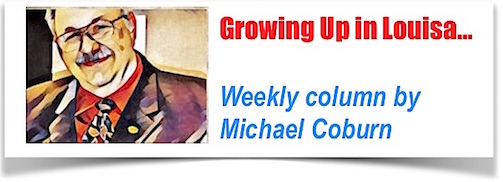Small Groceries and General Stores
The good folks of our generation grew up knowing bits and pieces of what was in their respective communities. We then witnessed the changes and can foresee more drastic changes to come. To explain, let me point out that in our little town there were a number of small ‘corner’ grocery stores that became the lifeblood of the community. This wasn’t unique at all because intersections of roads all around gave place to 
similar stores. These often carried a little different selection of merchandise that included oil, kerosene, and gasoline. The Country store or general store sometimes also carried sporting goods such as guns, ammo, and fishing bate or tackle. They might have carried wire fencing, tools, and farm implements. These were known as general stores since they carried dry goods, some clothing and shoes, groceries, tools, and toys. The often served as a local post office and sometimes a voting precinct. I’m thinking something like Sam Drucker’s store reenacted in TV’s Green Acres.
The country stores often had a pot-belly stove in the center for heat and a bunch of chairs for the farmer-patrons to fill at day’s end or weekends. A checker board was common, sometimes centered on a small makeshift table or barrel. They also had a large dill pickle barrel with a pair of tongs used to chase down the spicy treat. A few white waxed paper bags were supplied to encourage the customer to take a few instead of just one.
Local farmers sold their produce including eggs, fruit, chickens, turkeys, and fruit to be resold at the local stores. Baskets of fresh, farm supplied green beans, potatoes, corn, and squash sat out front for sale. Inside I remember the penny candy and nickel bars of candy. There was a cold water tub with bottled Nehi drinks, Coke, and Pepsi. I went for the breakfast cereal Cheerios, Rice Crispy, Wheaties, and Puffed Wheat, or Rice. Like Cracker Jacks these had prizes hidden inside for the lucky boy or girl who found them. I remember the rich smell of freshly ground coffee beans. I remember that to raise money they often had some punch cards that had various prizes, but guaranteed a prize every time.
Some of these businesses had a meat counter in the back where rare refrigeration was put to good use. Cured hams hung from a string and butcher paper was torn from a large heavy roll for wrapping each order. Whether a general store or a corner grocery, the orders were pulled by the grocer and the brown paper bag was used to tally the order. In those days, not too long out of the depression and during the Second World War, the final tally was entered into the charge account kept for each family. Of course this meant that the cost of the order was carried by the grocer until the end of the month, or whenever the date was set for paying off the bill. There were a few ‘cash and carry’ stores, but during these days in eastern Kentucky, and most places I suppose. There was a few families that had the ability pay cash but many had running charge accounts.
Orders were often called in by phone to the store. The merchant pulled the order and had it delivered by the delivery boy. Usually this was a young man who rode his bicycle to take the groceries to the customer. I remember when they would carry the stuff inside the kitchen and put the refrigerated food in the ice box or refrigerator. It didn’t matter if anyone was home because the door was never locked.

Having to carry this much debt for the community likely put the grocer in a precarious financial position that helped drive them out of business as the 60’s took over. Our little town got it’s first super market in the late fifties as far as I remember. These were much larger stores set up so the customer would fill their carts and take them to a cashier to make payment. While these early markets weren’t automated, many were made so over the next ten years or so. The grocer had to take regular inventories when they were closed to know what needed restocking. Bar coding did not appear on the scene in our little town but was starting to be used in the 70’s in the big cities. Keeping inventories became easier, but the keeping up with the equipment was expensive. This gave more advantage to the larger stores taking over the market.
The old community meeting places were obsolete. No more was there a potbellied stove, a checker board, a gather of men talking politics or considering next year’s crops. The old stores had plenty of men and women who found the old ways one of those happy chores but the new stores were not ‘hangouts.’ This continued to change until markets became the mega stores we have today. They offered many choices of products, brands and lower prices. Today’s box stores have grocery sections that may make up to twenty percent of the goods carried. Now they have nearly everything a family needs. The old-time grocer is so out-of-place they could not last long in the changing business environment.
Behind the scenes another difference has affected our communities. The corner stores and general stores usually carried the name of the owner. Those names often were adopted to describe the area around the store. Money made by the merchant went to raise his/her children and flowed naturally back into the community. Even the merchandise was purchased through a wholesaler from the area, but when the large markets moved in the prices of goods dropped below what local merchants needed to survive. To make matters worse, the profits left town and went into the pockets of investors many miles away. The local economy suffered resulting in many boarded up store fronts. Downtown businesses were bypassed, both literally and figuratively.

Years ago I wrote an article on this memory and others made comments about the vast changes mentioned. My late friend, Bernard Nelson, (RIP) wrote that he had been delivery boy for Ed Bradley’s grocery across the tracks at the depot. At first he used a heavy bike with wire baskets to carry the load, but later used a panel truck and delivered orders for multiple families on his trips around town. He would later work as a sheriff’s deputy and the town police.
Another friend told me that it was their job in the family to make up a grocery list and call it in. A while later the order would be carried in and put away. I wondered for a while why this level of customer service faded away in favor of the bigger ‘non-service’ stores. Well, guess what. We can now enter our order on our App and either swing by the store to pick them up, or wait for delivery at home. Some call that full-circle change, buy don’t be fooled. Customer service is starting to happen because of competition, but much of the profit is going out of state, or even out of the country.
I was a tiny little tyke when my mother first took me by the hand and walked me to a grocery store. As a little child it seemed to be a fascinating world of creaky wooden floors, stacks of boxes and counters. I’m picturing a man wearing a white apron and sweeping up the dust that had settled from the passing coal trains. In addition, I experienced various smells of freshly ground coffee beans and other aromatic products that arose from other corners of the store. There were bags of bread, sugar, flour, baking soda, tins of lard and shortening spread about on shelves around the store.
Since I was a kid, the attractions were the flashy advertisements on boxes of oatmeal and cereals. I liked the artwork, but not everything was artsy. There were bushel baskets of all kinds of vegetables in infinite varieties. Crowds of people were typically lined up on one side of tall wooden counters awaiting their turn to pass a list of needs to one of the grocers that was wearing a long bibbed apron. In those days the clerk or owner personally pulled the order for their customers and added up the costs by writing cyphers on the brown paper bags (pokes). For meat products there was a large white waxed roll of paper to wrap, tape and

add to the account and the large brown bag. I remember scales for weighing loose produce, and another counter that had a glass to show off (and protect) assortments of cookies and candy. It was those chocolates, mints, and hard candies that got my attention. I also remember the wax candy, some looking to be a set of lips. Another kind looked like a little bottle of pop. Those had a sweet, sticky syrup that would squirt into, or onto, our mouths when we bit into them.
As I grew up on Clay Street we used Adams grocery, which I believe was on the corner of Clay Street and Madison, just next to where our preacher stayed. When that store was torn down, or maybe even before, we went further down Madison and across the tracks to Bradley’s. I knew all the workers including the owners, but I especially enjoyed an occasional pat on the head from Glen or Ed Bradley. I’ve written about Ann Perry’s special Christmas candy that was sold around Christmas. Making the candy has become a tradition in my family. Thanks to Betty Hager Cooke, who helped make that original recipe of the wonderful, creamy sweets. If anyone is interested send me a request and I’ll send you a copy of the recipe.
I remember when Glen Bradley opened a second store. It was on Main Cross, but I rarely was in there. I continued to use Ed’s store. Glen’s store was more than twice the distance from home so we rarely went there. I don’t even know if we had an account there. A neighbor, Charles Walker bought into the store but I guess lost it when the train struck the gasoline truck at that intersection. That fire changed the face of the little town and sadly took a life, as well.
I have written an article before on Andy York’s little store on Sycamore and Lock Avenue. I was older and usually would be out on a bike ride around town when I visited him. My family visited his wife and parents fairly often. I found Andy to have a great sense of humor and was loads of silly fun. He allowed me to buy boxes of baseball cards at wholesale, but it wasn’t often since I rarely had enough money. I also remember fixing sandwiches from a cut of bologna, usually five cents worth. In those days I was very skinny, having very little to eat at home. That nickel’s worth of processed meat may have helped me make it through some of those days.
My gang of friends and I enjoyed stopping in Curtis Young’s grocery from time to time to have a pop and nickel bag of peanuts. Sometimes, when I had money I’d get a Moon pie. We would grab our drinks and go to his back porch and jump on his swing telling jokes or making plans to organize a ‘choose-up’ game of baseball.
There was another store in Little Italy and several sprinkled out toward High Bottom. There were several in Fort Gay, WV. I went over there to buy Verner’s Ginger Ale. It was the only place around that sold that product. Verner’s is very popular in Michigan and is well-known in Huntington, too. It is likely that after all these years I’ve left off your favorite grocer. If so, write a comment and give them credit. It may also jog my memory and tell me this column is read by someone. That gives me encouragement to keep plugging away on the weekly article.













![Foothills-Bundle] Foothills-Bundle](https://thelevisalazer.com/wp-content/uploads/2020/05/Foothills-Bundle-422x74.jpg)






Yes Mike your stories are enjoyed by me, I read them.
Mike, I lived many of the days this particular story is about. But would you be shocked too know that mine lasted until 2016? Yes, I would like to give credit too a man named Haynes Wells, who owned and operated ‘Well’s Feed Store’ in Greene County TN. He started in 1954, and ran his store until he passed, (or a few months before). His store was in an old long unused school. He had a wood stove as his only source of heat, he also lived in an offshoot of the building. He kept a huge book, on which was listed the credit accounts of nearly all the people in our area. He didn’t accept debit or EBT cards; and had a cash register likely from the 1930’s. Many was the day I would sit with a number of old men (of which I’ve become), and tell tales around the wood stove. At Christmas, he had a collection of candy not seen in years, (REAL peanut brittle my favorite), as well as ‘Hoop Cheese’ and other things so hard to find in these days. No checker board (sadly). All and all a place stuck in another day and time. I miss Haynes, I really do! His store is still there and I drive past almost daily. He had groceries, plumbing, hardware and could order things like grates for a fireplace if you wanted one, from where I don’t have a clue? Actually had kerosene lamps and such uncommon things in the 21’st century! I am a lucky man, to have seen this early in my life, and later on as well! Time marches on.
You were blessed. These storekeepers were community leaders and were respected by all. They made a difference and left a hole when shut down operations. I know their children who have grown up and are proud of their dad’s legacy. Thanks for sharing.
You are welcome, keep up the good work.
Hi Mike, I would love the candy recipe.
Your neighbor from Clay St.
Linda Lee